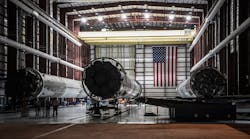Elon Musk laid out his long-promised vision for building a self-sustaining city on Mars, saying the next giant leap for humanity will require full rocket reusability, refueling the spacecraft in orbit and propellant production on the Red Planet.
“Refueling in orbit is one of the essential elements,” Musk told scientists, engineers and government officials gathered Tuesday at the 67th International Astronautical Congress in Guadalajara, Mexico, in a presentation called “Making Humans a Multiplanetary Species.” Musk went on to say that producing propellant on Mars was key to driving down the cost, which he estimated one day could cost roughly $200,000 per ticket.
The gathering, which included Apollo-era astronaut Buzz Aldrin, drew men and women who have spent lifetimes studying our solar system, the galaxies beyond, and how to get there one day. Musk’s comments hold sway because of his rocket-launch company’s success and the steps he’s already taking toward the goal of helping humans move beyond Earth.
Space Exploration Technologies Corp., the company he founded in 2002 with that intent, is already flying satellites into orbit and scheduling “Red Dragon” missions to explore the planet. Those missions will inform the design of the SpaceX Interplanetary Transport System, a larger craft to ferry people to Mars and beyond.
SpaceX released an four-minute animated video shortly before Musk’s speech that revealed how the Interplanetary Transport System would work. The video begins with more than a dozen people walking into the spacecraft perched atop a rocket booster that lifts off from Cape Canaveral, Florida.
Once in space, the spacecraft sits in a parking orbit while the booster returns to Earth to get a propellant tank. The rocket then reflies and refuels the spacecraft in orbit. With the additional fuel, the spacecraft then blasts off toward Mars thanks, in part, to solar arrays that deploy. At midjourney, it’s traveling at almost 62,700 mph toward the planet.



